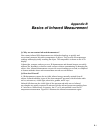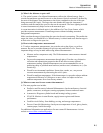
Appendices
Glossary A
A-5
Reflected Temperature Compensation
Correction feature used to achieve greater accuracy when, due to a high uniform
background temperature, infrared energy is reflected off the target into the instrument. If
the background temperature is known the instrument reading can be corrected by using
this feature. Targets that have low emissivities will reflect energy from nearby objects,
which may result is inaccurate readings. Sometimes objects near the target (machines,
furnaces, or other heat sources) have a temperature much higher than that of the target. In
these situations it is necessary to compensate for the reflected energy from those objects.
(RTC has no effect if the emissivity is 1.0.)
Relative Humidity
The ratio, expressed as a percent, of the amount of water vapor actually present in a
sample of air to the greatest amount of water vapor possible at the same temperature.
Repeatability
The degree to which a single instrument gives the same reading on the same object over
successive measures under the same ambient and target conditions (per the ASTM
standard test method E 1256-88).
Resolution
See Temperature Resolution or Optical Resolution.
Response Time
A measure of an instrument’s change of out-put corresponding to an instantaneous
change in target temperature, generally expressed in milli-seconds, for 95 percent of full
scale temperature indication (per the ASTM standard test method E 1256-88). The
specification for Fluke instruments also includes the average time required for software
computations.
Scatter (Size of Source Effect)
An undesirable increase in temperature reading caused by IR energy outside the spot
reaching the detector. The effect is most pronounced when the target is much larger than
the field of view.
Span
The full temperature span of the Imager is -10 °C to 350 °C (14 °F to 662 °F). The LCD
display shows about 256 shades of color for whatever pallet you select. Adjusting the
temperature span allows you to see more subtle temperature gradients in a captured
image.
Spectral Response
The wavelength region in which the IR Thermometer is sensitive.
Spot
The diameter of the area on the target where the temperature determination is made. The
spot is defined by the circular aperture at the target that allows typically 90% of the IR
energy to be collected by the instrument, as compared with the 100% spot diameter
which is defined by the IR energy collected from a very large target. The actual size and
distance to the target for the 100% spot diameter is specified in the calibration procedure
for each instrument.


















